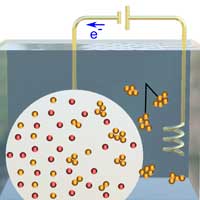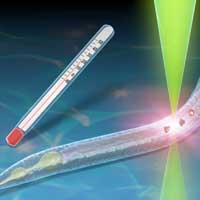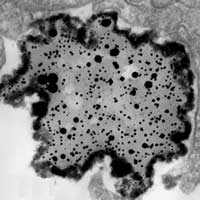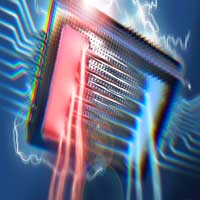 The proposed concept of metal expulsion from liquid alloys can be extended to a wide variety of molten metals for producing metallic and metallic compound nanostructures for advanced applications.
The proposed concept of metal expulsion from liquid alloys can be extended to a wide variety of molten metals for producing metallic and metallic compound nanostructures for advanced applications.
Friday, September 11, 2020
Growing metallic crystals in liquid metal solvent
 The proposed concept of metal expulsion from liquid alloys can be extended to a wide variety of molten metals for producing metallic and metallic compound nanostructures for advanced applications.
The proposed concept of metal expulsion from liquid alloys can be extended to a wide variety of molten metals for producing metallic and metallic compound nanostructures for advanced applications.
Nanodiamond quantum thermometer measures 'fever' in tiny nematode worms
 The connection between quantum sensing and biology ushers in novel thermal imaging technologies in biomedical research.
The connection between quantum sensing and biology ushers in novel thermal imaging technologies in biomedical research.
Understanding electron transport in graphene nanoribbons
 New understanding of the electrical properties of graphene nanoribbons, when bounded with aromatic molecules, could have significant benefits in the development of chemosensors and personalized medicine.
New understanding of the electrical properties of graphene nanoribbons, when bounded with aromatic molecules, could have significant benefits in the development of chemosensors and personalized medicine.
Biosynthesizing plasmonic gold nanoparticles within cancer cells
 Researchers demonstrate for the first time a method of biosynthesizing plasmonic gold nanoparticles within cancer cells, without the need for conventional bench-top lab methods.
Researchers demonstrate for the first time a method of biosynthesizing plasmonic gold nanoparticles within cancer cells, without the need for conventional bench-top lab methods.
Nano-microscope gives first direct observation of the magnetic properties of 2D materials
 Researchers show that it is possible to study the magnetic properties of ultrathin materials directly, via a new microscopy technique that opens the door to the discovery of more two-dimensional magnetic materials, with all sorts of potential applications.
Researchers show that it is possible to study the magnetic properties of ultrathin materials directly, via a new microscopy technique that opens the door to the discovery of more two-dimensional magnetic materials, with all sorts of potential applications.
Sustainable synthesis of carbon nanotubes
 Scientists explore the low-temperature growth of carbon nanotubes.
Scientists explore the low-temperature growth of carbon nanotubes.
Transistor-integrated cooling for a more powerful chip
 Researchers have created a single chip that combines a transistor and micro-fluidic cooling system. Their research should help save energy and further shrink the size of electronic components.
Researchers have created a single chip that combines a transistor and micro-fluidic cooling system. Their research should help save energy and further shrink the size of electronic components.
A multivalued optical memory composed of 2D materials
 Researchers developed a memory device capable of storing multiple values using both optical and voltage input values. This technology may be used to significantly increase the capacity of memory devices and applied to the development of various optoelectronic devices.
Researchers developed a memory device capable of storing multiple values using both optical and voltage input values. This technology may be used to significantly increase the capacity of memory devices and applied to the development of various optoelectronic devices.
New machine learning-assisted method rapidly classifies quantum sources
 Engineers created a new machine learning-assisted method that could make quantum photonic circuit development more efficient by rapidly preselecting these solid-state quantum emitters.
Engineers created a new machine learning-assisted method that could make quantum photonic circuit development more efficient by rapidly preselecting these solid-state quantum emitters.
Quirky response to magnetism presents quantum physics mystery
 Magnetic topological insulators could be just right for making qubits, but this one doesn't obey the rules.
Magnetic topological insulators could be just right for making qubits, but this one doesn't obey the rules.
Subscribe to:
Comments (Atom)
